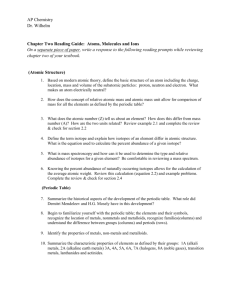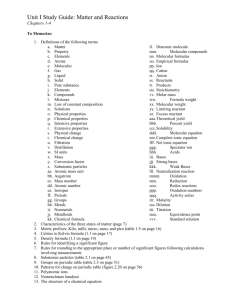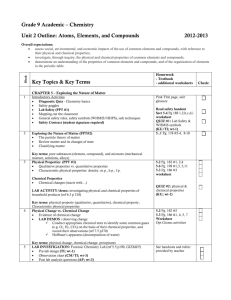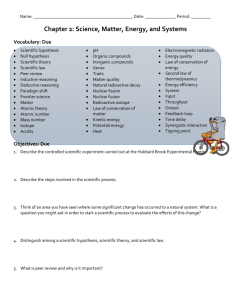Chem 1A Objectives and Skills Checklists
advertisement
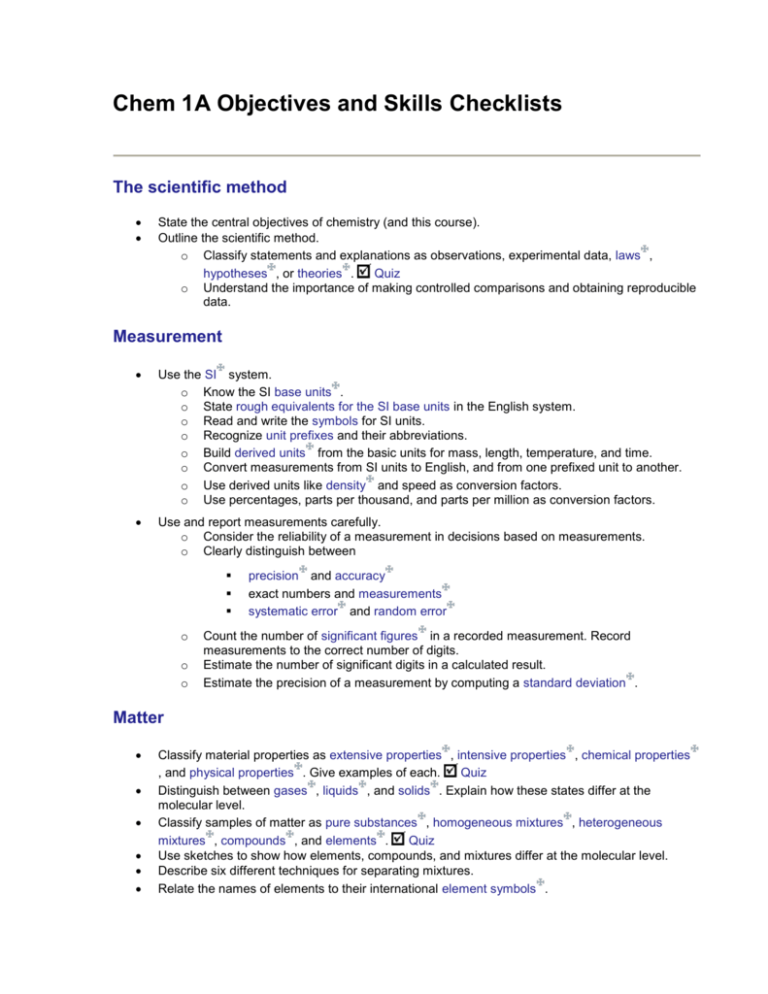
Chem 1A Objectives and Skills Checklists The scientific method State the central objectives of chemistry (and this course). Outline the scientific method. o Classify statements and explanations as observations, experimental data, laws , hypotheses , or theories . Quiz o Understand the importance of making controlled comparisons and obtaining reproducible data. Measurement Use the SI system. o Know the SI base units . o State rough equivalents for the SI base units in the English system. o Read and write the symbols for SI units. o Recognize unit prefixes and their abbreviations. o Build derived units from the basic units for mass, length, temperature, and time. o Convert measurements from SI units to English, and from one prefixed unit to another. o Use derived units like density and speed as conversion factors. o Use percentages, parts per thousand, and parts per million as conversion factors. Use and report measurements carefully. o Consider the reliability of a measurement in decisions based on measurements. o Clearly distinguish between o o o precision and accuracy exact numbers and measurements systematic error and random error Count the number of significant figures in a recorded measurement. Record measurements to the correct number of digits. Estimate the number of significant digits in a calculated result. Estimate the precision of a measurement by computing a standard deviation . Matter Classify material properties as extensive properties , intensive properties , chemical properties , and physical properties . Give examples of each. Quiz Distinguish between gases , liquids , and solids . Explain how these states differ at the molecular level. Classify samples of matter as pure substances , homogeneous mixtures , heterogeneous mixtures , compounds , and elements . Quiz Use sketches to show how elements, compounds, and mixtures differ at the molecular level. Describe six different techniques for separating mixtures. Relate the names of elements to their international element symbols . Describe the periodic table . Name the major groups and regions on the periodic table, and identify elements belonging to these groups. Distinguish between metals, nonmetals, and metalloids using the periodic table. Atoms and ions Describe early milestones in the development of modern atomic theory. State and apply the law of conservation of mass and the law of definite proportions . State the premises of Dalton's atomic theory. Describe J. J. Thomson's experimental evidence for the existence of electrons . Describe Rutherford's scattering experiments and show how the results of the experiments imply the existence of atomic nuclei . List the three most important particles that all atoms are composed of, and describe their charges and relative masses. Understand the concept of atomic weight . Describe how isotopic masses and isotopic abundances are measured experimentally using mass spectrometry . Use a mass spectrum to compute an average atomic mass. Given a table of isotopic masses and abundances, sketch a mass spectrum. Predict the most common ion formed by a main group element by consulting a periodic table. Name and write the formulas for common transition metal ions. Molecules and compounds Describe two fundamental types of chemical bonding . Compare properties of ionic compounds and covalent compounds . Classify compounds as ionic or covalent. Define and distinguish between empirical formulas , molecular formulas , and structural formulas for compounds. Define, calculate, and relate formula weights and molecular weights . Name and write the formulas for o o o o o polyatomic ions binary compounds (covalent or ionic) simple ionic compounds inorganic acids addition compounds Explain the mole concept, and convert between grams, moles, and atoms and molecules. Determine mass percent composition of a sample from experimental data. Determine mass percent composition of a compound from its formula. Determine empirical formula of a compound from its mass percent composition. Chemical change Write balanced chemical equations from descriptions of chemical changes. Classify chemical reactions as synthesis, formation, decomposition, thermolysis, electrolysis, displacement, single displacement, metathesis, precipitation, neutralization, redox, and combustion reactions. Write formation and combustion reactions for given compounds. Understand the concept of equilibrium solubility and use it to recognize saturated and supersaturated solutions. Explain why water can dissolve polar and ionic substances. Visualize the link between a solution's ability to conduct electricity and the degree of ionic dissociation . Classify solutes as strong acids , weak acids , strong bases , and salts . Classify solutes as strong electrolytes , weak electrolytes , and nonelectrolytes . skills to master for exam II Molarity Distinguish between saturated and supersaturated solutions. Predict amounts of reactants or products involved in a reaction involving solutions by using solution molarities as conversion factors. Use molarity as a conversion factor in dilution problems. Use molarity as a conversion factor in titration problems. Gases Understand the definition of pressure. Use the definition to predict and measure pressures experimentally. Describe experiments that show relationships between pressure, temperature, volume, and moles for a gas sample. Use empirical gas laws to predict how a change in one of the properties of a gas will affect the remaining properties. Use empirical gas laws to estimate gas densities and molecular weights. Use volume-to-mole relationships obtained using the empirical gas laws to solve stoichiometry problems involving gases. Understand the concept of partial pressure in mixtures of gases. Use the ideal kinetic-molecular model to explain the empirical gas laws. List deficiencies in the ideal gas model that will cause real gases to deviate from behaviors predicted by the empirical gas laws. Explain how the model can be modified to account for these deficiencies. Energy and chemical change Describe, distinguish, and relate the following properties. Predict whether these properties increase, decrease, or stay the same over the course of a given chemical or physical change. o temperature o thermal energy Understand heat on both theoretical and experimental levels. o o o o o Relate heat transferred to changes in thermal energy when no work is done. Relate heat to an object's mass and initial and final temperatures. Clearly distinguish heat and temperature. Explain how heat can be measured experimentally (calorimetry). Estimate the final temperature when hot and cold objects are brought into contact. Define heat capacity and specific heat. Describe how these quantities can be measured experimentally. Define enthalpy. Distinguish enthalpy from thermal energy. Describe how changes in enthalpy and thermal energy accompanying a chemical reaction can be measured calorimetrically. Define bond energy. Use tables of bond energies to estimate the enthalpy of a reaction. Write and manipulate thermochemical equations. o o Combine a set of step thermochemical equations to obtain a net thermochemical equation (Hess's Law) Write thermochemical equations for combustion and formation reactions. The quantum theory Relate wavelength , frequency , and velocity of waves. Explain how electromagnetic radiation is produced by an oscillating charge. Explain how electromagnetic radiation carries energy from a transmitter to a receiver. Describe the collapsing atom paradox. List wave behaviors, and distinguish them from particle behaviors. Cite experimental evidence that implies that electromagnetic radiation can display both wave and particle behaviors. Cite experimental evidence that implies that electrons display both wave and particle behaviors. Connect particle and wave properties of matter using de Broglie's hypothesis. Explain what a standing wave is. Compare a wave on a wire, a particle on a wire, and an electron on a wire. Show how de Broglie's hypothesis implies the existence of quantized energy states for standing electron waves. Show how quantum numbers arise for standing electron waves. State Heisenberg's uncertainty principle, and explain why it resolves the collapsing atom paradox. skills to master for exam III Electrons in atoms Explain the difference between a continuous spectrum and a line spectrum. Explain the difference between an emission and an absorption spectrum. Use the concept of quantized energy states to explain atomic line spectra. Given an energy level diagram, predict wavelengths in the line spectrum, and vice versa. Define and distinguish between shells, subshells, and orbitals. Explain the relationships between the quantum numbers. Use quantum numbers to label electrons in atoms. Describe and compare atomic orbitals given the n and quantum numbers. List a set of subshells in order of increasing energy. Write electron configurations for atoms in either the subshell or orbital box notations. Write electron configurations of ions. Use electron configurations to predict the magnetic properties of atoms. The periodic table Understand the rationale behind the DEFINE[periodic table]; view the table as an ordered database of element properties. Explain how the periodic table reflects the quantum mechanical structure of the atom. Explain and use DEFINE[periodic trends] in: o DEFINE[atomic radius] o DEFINE[ionic radius] o DEFINE[ionization energy] Explain the connection between ionization energy and metallic character. Chemical Bonding Intermolecular Forces Liquids Solids Solutions Relate the following solution concentrations. o molarity o percentage (w/w, w/v, and v/v) o molality o mole fraction o ppt, ppm, and ppb o pX Explain how a dilute solution with specified volume and concentration can be prepared from a stock solution. Define the following colligative properties, and give a molecular explanation of each. Show how the properties can be measured experimentally. o vapor pressure lowering (Raoult's Law) o freezing point depression o boiling point elevation o osmotic pressure Use basic relationships involving colligative properties to estimate the molecular weight of nonelectrolyte solutes. o Relate the vapor pressure of a solution with concentration and solvent vapor pressure. o Use the relationship between freezing point depression and solution molality to predict the molecular weight of a solute. o Use the relationship between osmotic pressure and solution molarity to predict the molecular weight of a solute.
